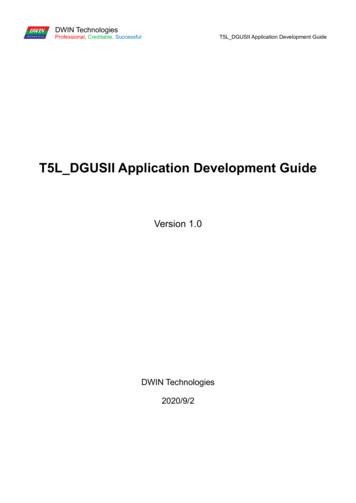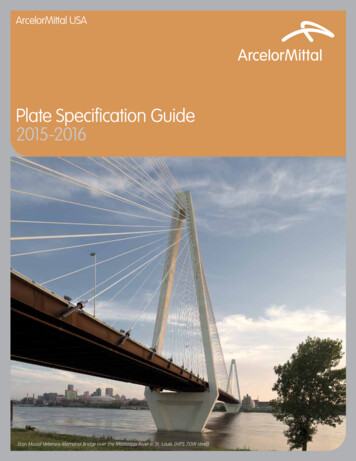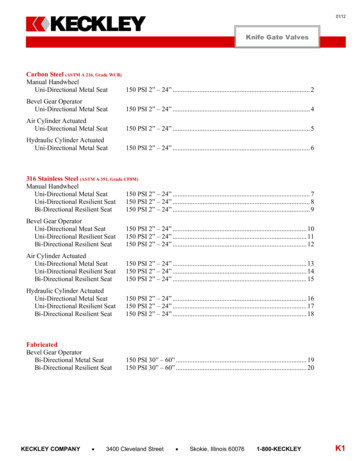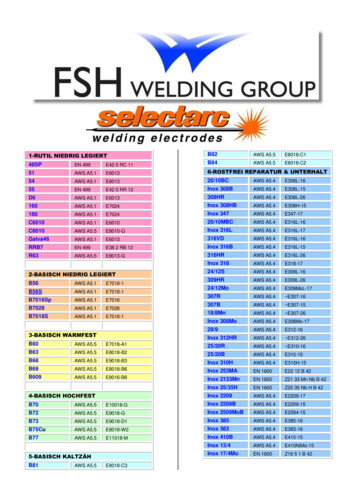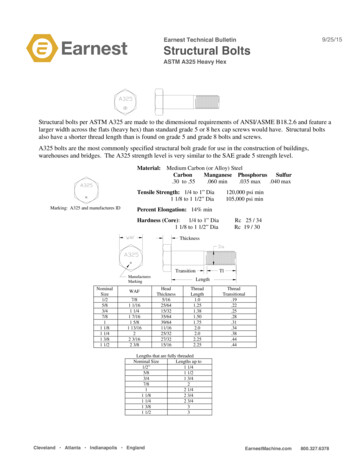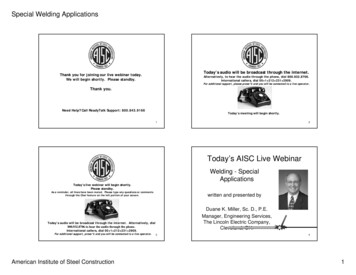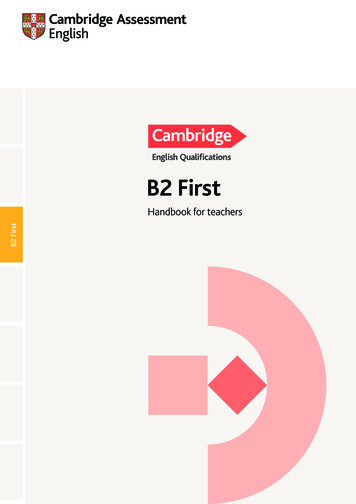
Transcription
K to Grade 2 Personal Health SeriesBreakfastKidsHealth.org/classroomTeacher’s GuideWe hear it all the time: “Breakfast is the most important meal of the day!” Thefollowing activities will help your students understand why a healthy breakfast isan important part of good nutrition and what they can do to start every day on theright track!This guide includes: Standards Related Links Discussion Questions Activities for StudentsRelated KidsHealth LinksArticles for Kids:Ready, Set, Breakfast! Reproducible MaterialsKidsHealth.org/en/kids/breakfast.htmlGo, Slow, and Whoa! A Kid’s Guide to Eating ardsMyPlate Food GuideThis guide correlates withthe following National HealthEducation Standards:Students will: Comprehend concepts relatedto health promotion anddisease prevention to enhancehealth. Demonstrate the ability to useinterpersonal communicationskills to enhance health andavoid or reduce health risks. Demonstrate the ability touse decision-making skills toenhance health. Demonstrate the ability to usegoal-setting skills to enhancehealth. Demonstrate the ability topractice health-enhancingbehaviors and avoid or reducehealth risks. Demonstrate the ability toadvocate for personal, family,and community health.KidsHealth.org/en/kids/pyramid.htmlHow to Read a ipesKidsHealth.org/en/kids/recipes/When Can I Make My Own mlDiscussion QuestionsNote: The following questions are written in language appropriate for sharing withyour students.1.When you wake up in the morning, what are the first things you do? Do you feelhungry when you wake up? Why do you think your body wants you to eat in themorning?2.What do you usually eat for breakfast? Which breakfast foods are good for you?Which breakfast foods should you only eat once in a while?3.People sometimes skip breakfast because they don’t have enough time in themorning. What are some things you can do to make sure you have time to eat ahealthy breakfast every morning?4.Describe your favorite breakfast.National Health EducationStandards: m 2015 The Nemours Foundation/KidsHealth. Reproduction permitted for individual classroom use.
K to Grade 2 Personal Health SeriesBreakfastActivities for StudentsNote: The following activities are written in language appropriate for sharing with your students.Breakfast BuffetObjectives:Students will: Describe what a healthy breakfast includes. Distinguish between healthy and unhealthy breakfast choices.Materials: Chart paperArt supplies (colored pencils, markers, crayons)Grocery advertisements or magazine pictures of different breakfast foods“Breakfast Buffet” handout or large sheets of plain paper“Breakfast Tracker” handout for extension activityClass Time:45 minutesActivity:What do you eat for breakfast? As a class, make a list of the different foods kids eat for breakfast. Your teacher canwrite down all the foods on chart paper. Be specific — for example, don’t just say “fruit,” but name the kind of fruit,like “apple” or “banana.”Some foods are healthier than others. “Go” foods are good to eat almost anytime because they are healthy (like skimmilk). Other foods are “Slow” foods. It’s OK to eat them, but not every day (like waffles). Finally, there are “Whoa”foods. These are the foods that are not very healthy, and you should only eat them once in a while (like bacon anddonuts). Which breakfast foods on the chart are “Go” foods? Which ones are “Slow” foods? Which ones are “Whoa”foods?Now, imagine you are a restaurant owner setting up a breakfast buffet. Draw pictures of the foods you would servefor breakfast. (Or, you can cut pictures out of magazines and grocery advertisements and paste them onto a bigsheet of paper.) Be sure to include lots of “Go” foods, some “Slow” foods, and only a few “Whoa” foods. When you’refinished, share your breakfast buffet with a classmate.Extension:Use the Breakfast Tracker handout to record (with words and/or pictures) what you eat for breakfast every day for aweek. At the end of the week, draw a circle around the “Go” foods, a triangle around the “Slow” foods, and a squarearound the “Whoa” foods. How many foods did you eat from each group? 2015 The Nemours Foundation/KidsHealth. Reproduction permitted for individual classroom use.
K to Grade 2 Personal Health SeriesBreakfastAdventures of Captain B. Fast!Objectives:Students will: Understand and explain the importance of eating a healthy, well-balanced breakfast. Suggest ways to make healthy breakfast choices.Materials: Plain paperArt supplies (colored pencils, markers, crayons)Class Time:40 minutesActivity:If it weren’t for Captain B. Fast, the caped breakfast crusader, kids around the world would be eating reallyunhealthy breakfasts! Just the other day, the Captain caught a kid about to chow down on 4 stacked pancakescovered with butter and drenched in maple syrup! In the blink of an eye, before the kid could even take a sip of hischocolate milk, Captain B. Fast had swooped into the kitchen and swapped his plate for one with 2 pancakes toppedwith fresh blueberries and a glass of skim milk on the side. Why did Captain B. Fast do that?Now for the Captain’s next adventure! Think of your favorite “Slow” or “Whoa” breakfast. What might Captain B. Fastdo to that meal? Draw a BEFORE and AFTER picture of your favorite breakfast. Be sure to label the foods, and showthe healthy changes that the Captain makes. When you’re finished, share your “new” breakfast with the class. Youcould even make a class booklet of the new-and-improved breakfasts!Reproducible MaterialsHandout: Breakfast trition/breakfast handout1.pdfHandout: Breakfast utrition/breakfast handout2.pdfQuiz: /nutrition/breakfast quiz.pdfAnswer Key: /nutrition/breakfast quiz answers.pdfKidsHealth.org is devoted to providing the latest children’s health information. The site, which is widelyrecommended by educators, libraries, and school associations, has received the “Teachers’ Choice Awardfor the Family” and the prestigious Pirelli Award for “Best Educational Media for Students.” KidsHealth comesfrom the nonprofit Nemours Foundation. Check out www.KidsHealth.org to see the latest additions! 2015 The Nemours Foundation/KidsHealth. Reproduction permitted for individual classroom use.
Personal Health SeriesBreakfastName:Date:Breakfast BuffetInstructions: Draw pictures of the foods you would include on your “Breakfast Buffet” table. Be sure to include lots of “Go” foods, some “Slow” foods, and only a few “Whoa”foods. When you’re finished, share your buffet with a classmate. 2015 The Nemours Foundation/KidsHealth. Reproduction permitted for individual classroom use.
Personal Health SeriesBreakfastName:Date:Breakfast TrackerInstructions: Write or draw a picture of what you eat for breakfast, every day, for 1 week (including Saturday and Sunday). Draw agreen “ ” around the “Go” foods. Draw a yellow “ ” around the “Slow” foods. Draw a red “ ” around the “Whoa” foods. At theend of the week, count how many foods you ate from each group.DAYSWHAT I ATE FOR BREAKFASTMONDAYTUESDAYWEDNESDAY 2015 The Nemours Foundation/KidsHealth. Reproduction permitted for individual classroom use.
Personal Health SeriesBreakfastName:Date:Breakfast TrackerDAYSWHAT I ATE FOR BREAKFASTTHURSDAYFRIDAYSATURDAYSUNDAY 2015 The Nemours Foundation/KidsHealth. Reproduction permitted for individual classroom use.
Personal Health SeriesBreakfastName:Date:QuizInstructions: Is this food a ”Go” food, a “Slow” food, or a “Whoa” food? Look at the picture and the word, then mark an “X” in thecorrect column.FOODGOSLOWWHOAapplebagelbaconchocolate milkpineapple inlight syrupdonutoatmeallow-fat yogurt 2015 The Nemours Foundation/KidsHealth. Reproduction permitted for individual classroom use.
Personal Health SeriesBreakfastQuiz Answer KeyFOODGOappleXSLOWWHOAXbagelXbaconXchocolate milkpineapple inlight syrupXXdonutoatmeallow-fat yogurtXX 2015 The Nemours Foundation/KidsHealth. Reproduction permitted for individual classroom use.
standards/index.htm. 2 The Nemours FoundationKidsHealth. Reproduction permitted for individual classroom use. . Grocery advertisements or magazine pictures of different breakfast foods “Breakfast Buffet” handout or large sheets of plain paper . light syrup donut oatme

